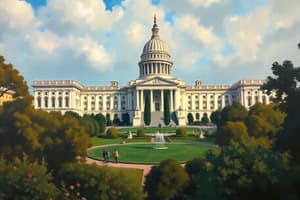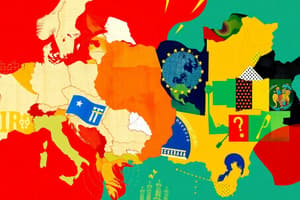Podcast
Questions and Answers
In a federal system, which mechanism typically delineates the scope of authority between central and regional governments?
In a federal system, which mechanism typically delineates the scope of authority between central and regional governments?
- A series of mutual agreements negotiated annually
- Judicial review based on customary law
- Executive decree issued by the head of state
- A written constitution outlining the distribution of powers (correct)
What is the core principle of federalism regarding sovereignty?
What is the core principle of federalism regarding sovereignty?
- Sovereignty is exclusively held by the central government to ensure national unity.
- Sovereignty is an obsolete concept in modern federal systems.
- Sovereignty is divided and sometimes shared between different levels of government. (correct)
- Sovereignty is primarily exercised by international bodies and treaties.
Why did James Madison advocate for a federal system in Federalist No. 10?
Why did James Madison advocate for a federal system in Federalist No. 10?
- To facilitate easier conquest of neighboring territories.
- To protect against the dangers of 'faction' and ensure democratic protections. (correct)
- To centralize power and promote economic efficiency.
- To establish a monarchy with limited powers.
What distinguishes federalism from other forms of government concerning the representation of people?
What distinguishes federalism from other forms of government concerning the representation of people?
Considering the structure of the POST/PLSC 3303 course, which assessment component emphasizes critical engagement with course themes through independent research?
Considering the structure of the POST/PLSC 3303 course, which assessment component emphasizes critical engagement with course themes through independent research?
In the context of the POST/PLSC 3303 course, what is the primary purpose of assigning readings to different groups for leading discussions?
In the context of the POST/PLSC 3303 course, what is the primary purpose of assigning readings to different groups for leading discussions?
How might the division of powers inherent in federalism complicate responses to national crises, such as a pandemic?
How might the division of powers inherent in federalism complicate responses to national crises, such as a pandemic?
What critical attribute defines federalism as a political and governing structure?
What critical attribute defines federalism as a political and governing structure?
In the context of federalism, what mechanism formally allocates powers to different levels of government?
In the context of federalism, what mechanism formally allocates powers to different levels of government?
What is the constitutional principle of paramountcy in a federation?
What is the constitutional principle of paramountcy in a federation?
Within Canada's constitutional framework, what is the primary function of Section 91 in the Constitution Act, 1867?
Within Canada's constitutional framework, what is the primary function of Section 91 in the Constitution Act, 1867?
Under what condition can the Parliament of Canada legislate on matters normally reserved for provincial legislatures?
Under what condition can the Parliament of Canada legislate on matters normally reserved for provincial legislatures?
Which of the following powers is exclusively granted to the Parliament of Canada under Section 91 of the Constitution Act, 1867?
Which of the following powers is exclusively granted to the Parliament of Canada under Section 91 of the Constitution Act, 1867?
How does the principle of paramountcy apply when both the federal and provincial governments enact laws that seemingly govern the same subject matter?
How does the principle of paramountcy apply when both the federal and provincial governments enact laws that seemingly govern the same subject matter?
In a federal system, what is the role of the written constitution regarding the powers of the federal and regional governments?
In a federal system, what is the role of the written constitution regarding the powers of the federal and regional governments?
Which of the following is an example of a power granted to the federal government, illustrating its control over national economic levers?
Which of the following is an example of a power granted to the federal government, illustrating its control over national economic levers?
What is the significance of enumerating specific powers in both Sections 91 and 92 of the Constitution Act, 1867, for Canadian federalism?
What is the significance of enumerating specific powers in both Sections 91 and 92 of the Constitution Act, 1867, for Canadian federalism?
What critical constraint has been imposed upon the application of the POGG power by judicial interpretation?
What critical constraint has been imposed upon the application of the POGG power by judicial interpretation?
What is the primary role of the Supreme Court of Canada (SCC) in the context of intergovernmental disputes?
What is the primary role of the Supreme Court of Canada (SCC) in the context of intergovernmental disputes?
In what critical aspect do scholars critique the current division of powers within the Canadian federal system?
In what critical aspect do scholars critique the current division of powers within the Canadian federal system?
Before 1949, which judicial body served as the ultimate authority for reviewing constitutional matters and intergovernmental disputes in Canada?
Before 1949, which judicial body served as the ultimate authority for reviewing constitutional matters and intergovernmental disputes in Canada?
What critical challenge arises from the inherent gaps within Canada's "jurisdictional map," as defined by the Constitution?
What critical challenge arises from the inherent gaps within Canada's "jurisdictional map," as defined by the Constitution?
Which of the following best describes the constitutional division of powers regarding criminal law in the outlined framework?
Which of the following best describes the constitutional division of powers regarding criminal law in the outlined framework?
Under the enumerated powers, which level of government has primary jurisdiction over marriage and divorce?
Under the enumerated powers, which level of government has primary jurisdiction over marriage and divorce?
Which statement correctly identifies the division of powers related to 'Indians, and Lands reserved for the Indians'?
Which statement correctly identifies the division of powers related to 'Indians, and Lands reserved for the Indians'?
Which of the following scenarios falls exclusively under provincial jurisdiction according to the enumerated powers?
Which of the following scenarios falls exclusively under provincial jurisdiction according to the enumerated powers?
Considering the division of powers related to financial institutions, which action falls under federal authority?
Considering the division of powers related to financial institutions, which action falls under federal authority?
Which governmental responsibility regarding prisons is assigned to the provincial level?
Which governmental responsibility regarding prisons is assigned to the provincial level?
Which area of law is likely to cause the most jurisdictional disputes between the federal and provincial governments, based on the listed powers?
Which area of law is likely to cause the most jurisdictional disputes between the federal and provincial governments, based on the listed powers?
A province introduces a new tax on streaming services operating within its boundaries. Under what authority can the province enact this tax?
A province introduces a new tax on streaming services operating within its boundaries. Under what authority can the province enact this tax?
A provincial government decides to create a new agency responsible for promoting trade and investment within the province. Which of the following powers would the province rely on to establish this agency?
A provincial government decides to create a new agency responsible for promoting trade and investment within the province. Which of the following powers would the province rely on to establish this agency?
A new technology emerges that does not neatly fall into any existing category of federal or provincial jurisdiction. How is this jurisdictional uncertainty typically resolved in Canada?
A new technology emerges that does not neatly fall into any existing category of federal or provincial jurisdiction. How is this jurisdictional uncertainty typically resolved in Canada?
In a federal system, how is the division of powers typically structured, according to K.C. Wheare's definition?
In a federal system, how is the division of powers typically structured, according to K.C. Wheare's definition?
Which of the following is the MOST accurate comparison between a federal system and a unitary state?
Which of the following is the MOST accurate comparison between a federal system and a unitary state?
What is the critical distinction between federalism and a confederation?
What is the critical distinction between federalism and a confederation?
Which of the following is a potential drawback of federalism?
Which of the following is a potential drawback of federalism?
What key structural benefit does federalism offer in preventing tyrannical government?
What key structural benefit does federalism offer in preventing tyrannical government?
Consider a nation transitioning from a unitary system to a federal one. Which essential change MUST occur for this transformation to be successful?
Consider a nation transitioning from a unitary system to a federal one. Which essential change MUST occur for this transformation to be successful?
In what way do the economies of scale apply to a federal system?
In what way do the economies of scale apply to a federal system?
How does federalism promote responsiveness to local communities, compared to a unitary system?
How does federalism promote responsiveness to local communities, compared to a unitary system?
Considering Canada's place as the 6th modern federation, what critical innovations might it have adopted from the preceding federations (USA, Mexico, Venezuela, Switzerland, and Argentina)?
Considering Canada's place as the 6th modern federation, what critical innovations might it have adopted from the preceding federations (USA, Mexico, Venezuela, Switzerland, and Argentina)?
Flashcards
Federalism
Federalism
The formal division of powers between a central government and regional governments.
Federalism Definition
Federalism Definition
Divides powers between multiple levels of government, where each level represents the same people within the same territory.
Sub-national Units
Sub-national Units
Sub-national units are regional governments within a federal system (e.g. provinces).
Constitutional Division of Powers
Constitutional Division of Powers
Signup and view all the flashcards
Federalist Papers
Federalist Papers
Signup and view all the flashcards
Advantages of Federalism
Advantages of Federalism
Signup and view all the flashcards
Course Participation
Course Participation
Signup and view all the flashcards
Written Constitution in Federalism
Written Constitution in Federalism
Signup and view all the flashcards
Paramountcy
Paramountcy
Signup and view all the flashcards
Section 91 (Canada)
Section 91 (Canada)
Signup and view all the flashcards
Section 92 (Canada)
Section 92 (Canada)
Signup and view all the flashcards
Peace, Order, and Good Government
Peace, Order, and Good Government
Signup and view all the flashcards
Regulation of Trade and Commerce
Regulation of Trade and Commerce
Signup and view all the flashcards
Unemployment Insurance (federal)
Unemployment Insurance (federal)
Signup and view all the flashcards
Federal Taxation Power
Federal Taxation Power
Signup and view all the flashcards
Postal Service (federal)
Postal Service (federal)
Signup and view all the flashcards
Size Benefits: Preventing Tyranny
Size Benefits: Preventing Tyranny
Signup and view all the flashcards
Size Benefits: Economies of Scale
Size Benefits: Economies of Scale
Signup and view all the flashcards
Size Benefits: United Front
Size Benefits: United Front
Signup and view all the flashcards
Responsiveness to Local Communities (Federalism)
Responsiveness to Local Communities (Federalism)
Signup and view all the flashcards
Equity Among Constituent Units
Equity Among Constituent Units
Signup and view all the flashcards
Confederation
Confederation
Signup and view all the flashcards
Devolution
Devolution
Signup and view all the flashcards
Unitary State
Unitary State
Signup and view all the flashcards
Banking (Federal)
Banking (Federal)
Signup and view all the flashcards
Paper Money (Federal)
Paper Money (Federal)
Signup and view all the flashcards
Patents (Federal)
Patents (Federal)
Signup and view all the flashcards
Copyrights (Federal)
Copyrights (Federal)
Signup and view all the flashcards
Naturalization (Federal)
Naturalization (Federal)
Signup and view all the flashcards
Provincial Taxation
Provincial Taxation
Signup and view all the flashcards
Provincial Borrowing
Provincial Borrowing
Signup and view all the flashcards
Provincial Lands
Provincial Lands
Signup and view all the flashcards
Provincial Prisons
Provincial Prisons
Signup and view all the flashcards
Provincial Licensing
Provincial Licensing
Signup and view all the flashcards
POGG (Peace, Order, and Good Government)
POGG (Peace, Order, and Good Government)
Signup and view all the flashcards
Jurisdictional Gaps
Jurisdictional Gaps
Signup and view all the flashcards
Charter Compliance
Charter Compliance
Signup and view all the flashcards
Judicial Review
Judicial Review
Signup and view all the flashcards
Study Notes
- POST/PLSC 3303 is a course in the Department of Economics Justice & Policy Studies.
Course Components
- Participation is worth 15% of the grade and includes attendance and contributions to discussions related to readings
- The Midterm Examination is worth 25% of the grade and is scheduled for February 12, 2025 and a study guide will be posted on D2L.
- The Briefing Note is worth 30% of the grade, is due March 21, 2025, and the topic will be based on a list of ideas posted on D2L with the proposal due February 28, 2025.
- The Final Examination is worth 30% of the grade and a study guide will be posted on D2L with scheduling by the registrar.
- Some readings will be assigned to different groups to lead discussions and provide critical evaluation.
Federalism Defined
- Federalism divides powers between multiple levels of government.
- Federalism is a structure where multiple levels of government represent and are responsible to the same people within the same territory.
- Federalism is the division of powers between a central government and regional "sub-national units".
- Jurisdictions/powers are distributed in a constitution while sovereignty is both divided and sometimes shared.
Why Federalism
- Federalist 10, by James Madison (1751-1836), discusses federalism.
- The Federalist Papers include writings by Alexander Hamilton, James Madison, and John Jay(Publius).
- Federalism provides democratic protections against faction and inadequate representation.
- James Madison identified the problem of 'faction' and its relation to democratic freedom using the term "tyranny of the majority".
- “Faction' concerns a number of citizens acting on a common impulse that goes against the rights of other citizens or the community's interests.
- The solutions for 'faction' involve removing its causes(destroying liberty) and controlling its effects.
- A federal republic can control the effects and will have a large national government with representative democracy.
- The size and diversity of a large country make it harder for any one faction to dominate.
- Local governments can be more sensitive to communities, but prevent factions from causing tyranny.
- Representative democracy can promote sensible statespeople with 'enlightened views and virtuous sentiments'.
- Federalism balances benefits of size with prevention of tyrannical government.
- Federalism distributes/limits power and has Constitutional limits/protections.
- Federalism allows for economies of scale, a united front, responsiveness to local communities and equity among constituent units.
- Political scientist K.C. Wheare defined federalism as the division of government powers.
- K.C. Wheare stated that there is a single independent authority for the whole area in respect to some matters, and that there are authorities coordinate with, and not subordinate to, the others within its own prescribed sphere."
- There are about 25 federal states around the world.
- Canada was the 6th modern federation in history, after the USA, Mexico, Venezuela, Switzerland, and Argentina.
- The USA was the first modern federal system.
- Others include Australia, Germany, Belgium, India, and Brazil.
- Federations can be presidential republics or parliamentary democracies or a mixture.
- A continuum of centralization exists among separation(sovereign states), decentralization(confederation and federalism), centralization(devolution) to the integration of unitary states.
Why Federalism Was Suited to Canada
- Decentralization is an alternative to remote national governments.
- Federalism is advantageous where linguistic, religious, or cultural diversity are factors.
- Federalism Provides a check on government power.
- The 'Fathers of Confederation' chose federalism in Canada to manage francophone and anglophone tensions.
- Quebec's concerns about losing power were a consideration
- It was adopted to protect the Maritimes' interests.
- The member colonies of Canada had experience with self-governance and had developed their own political cultures that they wanted to preserve.
- Federalism allowed autonomy and diversity.
Federalism in Canada - Models
- Bakvis & Skogstad outlined Models to define Canadian federalism
- Watertight compartments happened between 1867 – 1930s.
- Consultation & coordination happened between 1930s – 1950s.
- Cooperative federalism happened between 1950s – 1960s.
- Competitive federalism happened between 1970s – 1980s.
- Collaborative federalism happened between 1990s – 2000s.
- Open federalism happened between 2006-11.
- Canada also contains intrastate, interstate and executive federalism.
- Interstate federalism formalizes relations between national and provincial governments resembling relations between countries.
- Intrastate federalism addresses federal concerns via national government institutions.
- Executive federalism is where the executives of both levels of government compete & collaborate.
- Due primarily to our Westminster-style parliamentary system, "executive federalism” has been the prevailing pattern in Canada.
Federalism Objectives
- One primary objective of federalism is to strike a jurisdictional balance between 2 levels of government.
- Federalism is a political arrangement that institutionalizes diversity.
- Federalism builds nationhood and national unity via levels of government where none is present naturally.
- Federalism is an artificial political and governing structure.
Federalism Constitutional Parameters
- Government powers are divided and distributed using a written constitution detailing which level gets to do what.
- Federations typically have a constitutional principle (or doctrine) of paramountcy.
- Paramountcy means that if there's a clash between similar federal and provincial powers, the federal power indicated in the constitution prevails.
- The Constitution Act, 1867 (the BNA Act) contains 2 division of powers sections: Section 91 and Section 92
- Section 91 enumerates federal powers while section 92 specifies provincial powers.
- Section 91 deals with Public Debt and Property, Trade and Commerce , Unemployment insurance, Taxation, Postal Service, ect
- In Section 92 Each Province makes Laws in relation to: Direct Taxation, Borrowing of Money , Public Lands, Prisons, Marine Hospitals , and Municipal Institutions
- Additionally each Province makes Laws in relation to : Licenses, Local Works , Incorporation of Companies, Marriage, Property and Civil rights etc
- S.92(16) indicates Matters of a merely local for private nature in the province
- Other sections provide the provinces jurisdiction over renewable resources and education.
- Concurrent jurisdiction is where both Ottawa and the provinces have jurisdiction.
- Immigration and agriculture are two examples.
- The BNA Act/CA 1867 reflects an intention for the federal government to be the dominant power.
- That intention is found in Ottawa's "4 autonomous powers" contained in the CA 1867.
- Section 90, the federal powers of reservation last used 1961 are re: provincial laws and disallowance used in 1943.
- Sections 91(29) and 92(10)(c) concern the federal declaratory power over provincial legislation last used in 1961.
- The preamble to section 91 contains the P.O.G.G. power - peace, order, and good government.
- Only POGG is an active law of the 4 autonomous powers.
- Additionally, the other 3 powers are either dormant or spent.
- POGG, aka the residual clause, has been limited to 3 contingencies: emergency use; to fill in gaps where jurisdiction is not settled; when a "national concern" exists.
- Gaps exist between the “jurisdictional map" provided by the Constitution, and what goes on in governments.
- Federal/provincial government's actions must be compliant with the Charter.
- The overlapping powers and federal financial dominance is a poor guide to determining levels within the federal system.
- Many lines are now blurred between which level does what.
- There is a significant degree of collaboration between the two levels as well as significant amounts of conflict.
- Such conflicts end up at the Supreme Court of Canada (SCC) to decide intergovernmental disputes via judicial review of the constitution.
- Prior to 1949, the highest court reviewing such matters was the Judicial Committee of the Privy Council [JCPC].
- Courts provide constitutional protection of rights + clarity/protection of the division of powers.
- Debates persist between parliamentary and judicial supremacy.
Federalism Basic Types
- The American model is a presidential republic.
- The Canadian model is a parliamentary democracy.
- The German model is a traditional continental European model with a council as 2nd chamber.
- The European Union (EU) model is a confederate, not federal, structure.
Federalism Complexities
- Complexities include Bicameral Legislatures and restraints upon the pure democracy of majority rule.
- Bicameral legislatures include Canadian Senate, German Bundesrat, United States Senate.
- Executive Federalism seeks to leverage collective power of regional governments.
- First Ministers Conferences are a form of executive federalism and can raise democratic questions
- How public finances are allocated represents Fiscal Federalism and are often contentious
- Fiscal Federalism often blurs accountability and responsibility while raising democratic challenges
- Asymmetrical Federalism is where different regional governments are more sovereign/ have more powers than others.
- Where governments are interdependent areas exist where powers overlap, intersect, and conflict.
- Federalism = negotiation/bargaining/diplomacy – compromise, cooperation & contention
- "sunny ways" represents Justin Trudeau's borrowing from Wilfred Laurier's approach to the Francophone language dispute in Manitoba.
- Both overt challenges – political & legal exist.
Federalism Contested Concepts
- Provincial equality occurs vs cultural dualism.
- Symmetry exists vs asymmetry.
- Federalism often does not reflect First Nations with visions on how to relate with the Canadian State.
- It occurs with Indigenous people living off-reserve.
- Economic balance complications occurs – as elsewhere in our federation.
- Autonomy vs interdependence are concepts in contention.
- At its best can establish universal standards and protections while allowing flexibility in program design/delivery – “Althusian compromise".
Studying That Suits You
Use AI to generate personalized quizzes and flashcards to suit your learning preferences.
Related Documents
Description
Explore federalism's core principles, including the division of powers and sovereignty. Understand its mechanisms, representation, and challenges in crises, drawing from course examples, and James Madison's arguments. Explore critical engagement with course themes through independent research in the POST/PLSC 3303 course.




